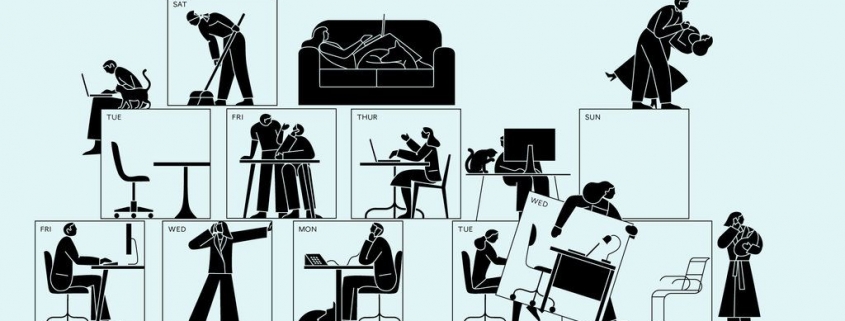Rethinking the Work Schedule
The coronavirus has changed the workplace in ways that will permanently transform the future of most organisations. Many leaders have been forced to craft new and improved strategies for successfully running an office remotely, building environments that help — not hurt – our immune systems, and developing guidelines to enforce safety measures like social distancing. Perhaps the most common change designed to address all of these areas is rethinking the employee work schedule, whether it is to support changes in work-life balance, to minimise social contact, or to meet wavering business demands. The traditional nine-to-five workday is no longer the gold standard.
Responsibility for gathering relevant information, identifying alternative schedule options, and implementing the new schedule is often given to the Human Resources (HR) manager. Since information on the subject is surprisingly scarce, this responsibility can be quite a challenge. It’s not something you do every day. Few people have the expertise to design a schedule for a group that works more than five days a week or more than one shift a day. Once you realize that schedule design is not the only step in changing schedules, nor the most difficult, you easily can be overwhelmed.
Despite the difficulty, this is a great opportunity for HR managers to orchestrate a significant change in the organisation. As an HR manager, you are uniquely qualified to do this. You tend to have a broader perspective than line functions such as production or maintenance. You have more experience in communicating with employees. Your on-going role as a company steward has trained you to protect organizational interests while addressing employee concerns.
Organisations change the work schedules of their non-exempt employees for a variety of reasons:
- Change the hours/days of operation to match the demand for their products or services.
- Fix problems such as high absenteeism, hiring/retention issues, or excessive overtime.
- Improve efficiency (e.g., lean manufacturing) or lower the operating costs.
- Respond to employee requests for change or complaints about the current schedule.
The Process of Change
In today’s tight labour market, organisations simply can’t afford to lose employees. Changing work schedules is an easy way to alienate the workforce and increase turnover. To ensure widespread support for the change, you need to have a plan for involving the key stakeholders and keeping them informed throughout the entire change process.
That sounds simple enough, but it’s actually the most difficult part of changing schedules. People are resistant to any kind of change. When it comes to work schedules, even a minor change can make a significant difference in employees’ lives. For example, changing the time that the work starts by 15 minutes may seem trivial, but it can have serious repercussions for people who commute in a carpool or use public transportation, parents with day-care requirements, and individuals with hundreds of other personal commitments built around their work schedules.
Availability of Resources
How many employees are needed to satisfy the coverage requirements? How many hours will they have to work each week? In addition to the base coverage, you need to consider absences such as vacations, illness, training, etc. Additional staff and / or overtime may be needed to cover these situations. Even though you think you have sufficient personnel, if a number of employees want to take a vacation at the same time, this could leave you short-handed. If someone takes a leave of absence due to health problems, pregnancy, or family care, you may not be able to replace them. The use of temporary employees may help, assuming you can find someone with the necessary skills.
Schedule Conflicts
Schedule constraints include legal considerations (e.g., state laws requiring overtime to be paid after 8 hours of work) and union agreements (e.g., limits on the number of consecutive days worked). There are also company policies to consider. For example, your company may require that all employees rotate so they spend an equal amount of time on every shift.
These are referred to as “constraints” because they limit the number of possible schedules. If you need an 8-hour fixed shift schedule with a maximum of 5 days worked in a row, you’ll be hard-pressed to come up with a schedule that gives you a lot of weekends off or long breaks. Without the constraint on the number of consecutive days worked, you would have a lot more options to choose from. Without the fixed shift constraint, you would also have more choices. If there are too many constraints, it may be necessary to add more workers, increase overtime, or sacrifice some coverage.
Changing employee work schedules is not a simple task. There is a lot more involved than simply finding a work pattern that matches the new hours of operation or accommodates a preferred shift length. The six major considerations are the change process, coverage requirements, available resources, schedule constraints, employee preferences, and company policies. Skipping any one of these can result in implementation delays, unhappy employees, damage to your relationship with workers, poor business results, and higher costs. However, with proper planning, preparation, and communication, it is possible to produce a win-win result for employees and the organisation.
Changing your organisation’s work schedules may be one of the most important tasks you undertake in your career. Not only is the schedule vital to the performance of your company, but it is also an integral part of your employees’ lives. The time and effort you invest will increase the chances of achieving a positive outcome for everyone affected by the new schedule.
This pandemic has revealed that some jobs, such as healthcare, are truly essential, and employees in that sector have to work difficult hours. At the same time, the post-pandemic period may be a time for organizations and society to reconsider the definition of essential. For instance, moving forward, is it really necessary for workers to be available at all hours, year-round, to provide nonessential services at retail and fast food places?
The key will be finding a balance between short-term business needs and the long-term benefits that new scheduling strategies bring to both employees and the organisation.
To summarise, rather than being mechanistic, organisations can take a more organic approach and allow employees to play a bigger role in determining when they want to work. We have already seen considerable discussion lately about where (e.g., from home) and how (e.g., using video conferencing technology) people will work in a post-pandemic world, but additional thought should also be given to when everyone works. Managers are encouraged to thoughtfully consider the schedules that are right for them as they return to their places of work.
Given our current situation knowing that your colleagues or employees are best suited for this new scenario we find ourselves in. Finding the right talent, the best fit for the job and your organisation can be a very challenging task. It is now important to find out whether your managers or your team is well-equipped of working together from various locations. It requires deep knowledge of their personalities, strengths, weaknesses, interests, work style and other characteristics. Our technology and solutions will do the work for you, helping you discover if your people are resilient during times of hardship, if they are autonomous, if they are team players, without actual human contact. Given that our platform is cloud-based, everyone can use it from home as well. Humanity finds itself at a crossroad for various reasons now, why not help people discover and develop themselves from the comfort of their own homes?
Request a free demo:

Sources:
https://hbr.org/2020/07/rethinking-work-schedules-consider-these-4-questions
https://shift-work.com/about/changing-schedules/
https://www.nytimes.com/2016/02/28/magazine/rethinking-the-work-life-equation.html











